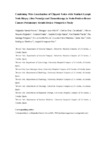Combining wire localization of clipped nodes with sentinel lymph node biopsy after neoadjuvant chemotherapy in node-positive breast cancer: preliminary results from a prospective study

Ver/Abrir
Use este enlace para citar
http://hdl.handle.net/2183/41176Colecciones
Metadatos
Mostrar el registro completo del ítemTítulo
Combining wire localization of clipped nodes with sentinel lymph node biopsy after neoadjuvant chemotherapy in node-positive breast cancer: preliminary results from a prospective studyAutor(es)
Fecha
2020-07-28Cita bibliográfica
García-Novoa A, Acea-Nebril B, Díaz Carballada C, Bouzón Alejandro A, Conde C, Cereijo Garea C, Varela JR, Santiago Freijanes P, Antolín Novoa S, Calvo Martínez L, Díaz I, Rodríguez Martínez S, Mosquera Oses J. Combining wire localization of clipped nodes with sentinel lymph node biopsy after neoadjuvant chemotherapy in node-positive breast cancer: preliminary results from a prospective study. Ann Surg Oncol. 2021 Feb;28(2):958-967.
Resumen
[Abstract]
Background: The ideal technique for lymph node staging for patients with pathologically confirmed node-positive breast cancer at diagnosis and neoadjuvant chemotherapy (NAC) is unclear.
Objective: The aim of this study was to analyze the feasibility of wire/clip localization and sentinel lymph node biopsy (SLNB) for the axillary staging of these patients.
Methods: We conducted a prospective study in which lymph node staging was performed using wire localization of positive lymph nodes and an SLNB with dual tracer. All patients who presented no metastatic involvement of the sentinel lymph node (SLN) or clip/wire-marked lymph node were spared an axillary lymph node dissection (ALND). The multidisciplinary committee agreed on axillary treatment for patients with lymph node involvement.
Results: Forty-two patients met the inclusion criteria. We identified and extirpated the clip/wire-marked node in all patients (100%), with SLNB performed successfully in 95.3% of patients. The SLN and wire-marked node matched in 80% of patients; 73.8% of patients did not undergo ALND.
Discussion and conclusions: Several studies have evaluated the efficacy of various procedures for lymph node marking for women with prechemotherapy lymph node involvement. Most of the studies reported high identification rates (> 94.8%), with false negative rates of < 7%. Similarly, our study allows us to conclude that combined axillary marking (clip and SLNB) in patients with metastatic lymph node at diagnosis and NAC offers a high identification rate (100%) and a high correlation between the wire-marked lymph node and the SLN (80%). This procedure has enabled the suppression of ALND for a significant number of patients (73%).
Palabras clave
Breast neoplasms
Sentinel lymph node biopsy
Sentinel lymph node biopsy
Versión del editor
Derechos
This version of the article has been accepted for publication, after peer review and is subject to Springer Nature’s AM terms of use, but is not the Version of Record and does not reflect post-acceptance improvements, or any corrections. The Version of Record is available online at: https://doi.org/10.1245/s10434-020-08925-5
ISSN
1068-9265





